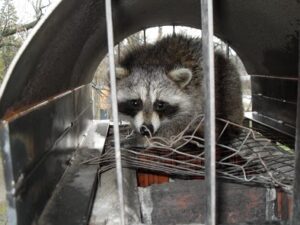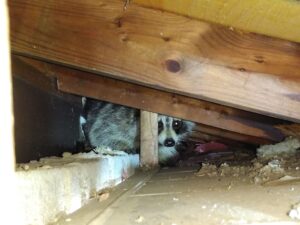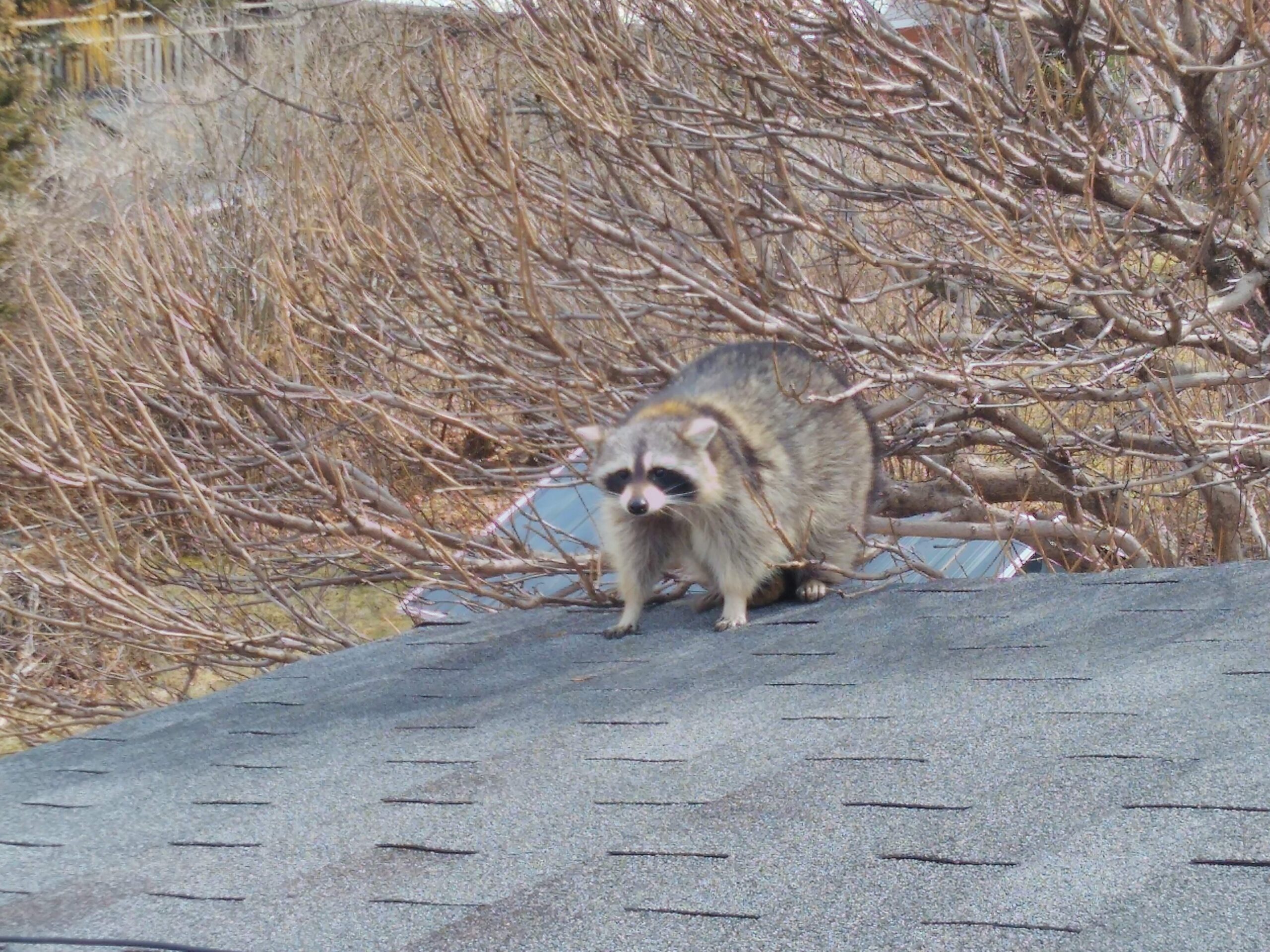Have you ever wondered what it is like to be a raccoon? Sometimes the only way to truly understand wildlife we see every day is to step into their shoes – or, in this case, paws. In fact, putting yourself in the raccoon’s position may help to understand the animal better and recognize why humane raccoon removal should really be the only option you consider when faced with a wildlife invasion on your property. Skedaddle deals with a variety of calls from homeowners encountering unwanted raccoon visits. Our technicians share some helpful tips and information about preventing raccoons from making your home theirs and what these animals are up to during the day.
What do Raccoons do during the day?
 Seeing a raccoon during the day isn’t incredibly rare, and it doesn’t always mean they’re wounded or sick. However it can be a cause for concern as many times raccoons will be around in daylight if they’re rabid. You may notice they are lethargic and have little awareness of their surroundings.
Seeing a raccoon during the day isn’t incredibly rare, and it doesn’t always mean they’re wounded or sick. However it can be a cause for concern as many times raccoons will be around in daylight if they’re rabid. You may notice they are lethargic and have little awareness of their surroundings.
Injured raccoons also might be spotted in the day, mainly because they’re in pain and searching for safety.
Raccoons will sometimes come out of their dens to forage food and will be acting relatively normal. In many circumstances raccoons will search for a snack if they’ve been up all night looking after their babies. Females have a greater responsibility with a family. There are more mouths to feed. Therefore, they might break their normal hours and need to find a greater supply of food.
Baby raccoons are curious. They’re still learning and seeing everything for the first time. Sometimes they can become impatient and wander out of the den during the day. They will start to become accustomed to the area and environment outside their home. It’s part of their necessary education in growing into an adult raccoon.
A typical day in the life of a raccoon would be pretty quiet as they are rarely out and about during the day. Some exceptions could be that the mama is pregnant and out hunting for certain kinds of food. Most raccoons tend to rest in their den while the sun is up. A mother raccoon with new kits will be busy caring for them during the day, and only venture out of the den when absolutely necessary.
Raccoons live a relatively carefree life.
For starters, raccoons don’t need to worry about paying rent. They are free to choose from one or more of the many abandoned holes to establish a den. And guess what? There are many alternate dens to switch between if necessary.
No need to worry about dieting today.
Raccoons don’t worry even a little bit about limiting their calories. In fact, they try to increase them to establish some fat stores to survive the winter. They will eat just about everything from fruits, vegetables, leftover chinese food, even insects and small animals . The world’s trash bins are their buffet table! Food is always plentiful as human beings are always busy producing more and more garbage.
Are Raccoons Mainly Nocturnal?
For the most part raccoons forage, wander and explore during the night. This is why we sometimes wake up to a destroyed garbage container, with little to no knowledge of how it happened, and the culprits are long gone.
Raccoons are stars of the night scene. They are most active in the darkest hours, which means being up and about somewhere between dusk to early morning hours. Incidentally, this is also when most human activity is scaled down, giving the raccoons free reign over the spoils of domestic and commercial waste.
Raccoons don’t go into hibernation during the colder months, but will spend more time inside their cozy warm den and only venture out when it is absolutely necessary. They are also actively mating during the late winter to early spring.
Keep those Raccoons Away with these Prevention Tips
Raccoons are always looking for a warm place to sleep, and a food source. While professional raccoon prevention is the most effective, there are some tactics you can use to discourage raccoons from moving into your attic, basement or property:
- Be sure you aren’t setting out any appetizing entrees for your local wildlife. Pet food, loose garbage cans and other treats are easy pickings for clever raccoons. Placing your garbage in a can may not be enough, so look for one with a firm closure, or keep your garbage in a shed.
- Take some time to raccoon-proof your home. One of our experts can help you check for common entrances. Raccoons can squeeze into holes as small as three inches in diameter and they can be creative when finding an entry point. Loose soffits, broken basement windows and holes near your crawlspace are common areas that raccoons scope out when looking for a warm home.
 The daily life of a female raccoon changes in the spring. Most raccoons only have one litter per year, but they can have a second litter if none of the first one survives. Mother raccoons look for a warm, safe place to have their litter between February and April.
The daily life of a female raccoon changes in the spring. Most raccoons only have one litter per year, but they can have a second litter if none of the first one survives. Mother raccoons look for a warm, safe place to have their litter between February and April.
This makes it even more difficult to humanely remove raccoons. Raccoon removal in the spring could leave between two and five baby raccoons in your home, so it’s particularly important to work with a professional during this time.
Any interaction with raccoons is best performed by our experts. At Skedaddle Humane Wildlife Control, we can offer personalized tips and professional techniques to discourage raccoons from eating, sleeping and relieving themselves on your property. From sealing your home to professional cleaning agents to remove a raccoon latrine, work with one of our experts to find out how we can prevent raccoons from moving in.
Signs of a Raccoon on your Property
- A strong and strange smell.
- Damage to outer areas of your home.
- Strange noises such as rustling, scratching or whimpering (usually at night).
- Regular raccoon sightings around your home.
- A raccoon entry point, marked with staining or fur.
Raccoons can quickly become a nuisance if they decide to den on your property. They get into the garbage. Live in your attic or chimney and cause lots of damage and contamination.
How to Remove Raccoons from Your Home
Once you have a raccoon setting up a home on your property it can be difficult to safely remove them. Raccoons can be infected with rabies, canine distemper and other viral diseases. When cornered, they can also become quite aggressive. Don’t pick a fight with a raccoon by attempting to catch or touch it. Attempting to snare or trap a raccoon on your own may result in injuring it.
Instead, turn to a professional team at Skedaddle Humane Wildlife Control for a three-step removal process:
- Assess the raccoon entry points and safely remove any raccoons and babies.
- Clear your home of raccoon feces and evidence of your unwelcome guests.
- Prevent another raccoon from moving in and protect your property.
Raccoons mothers often have multiple dens in a neighbourhood. While your home may be the lucky den that currently has a litter of babies, mothers are capable of safely moving her babies to another site. We assess the situation and use a heated baby box to humanely remove and reunite any raccoon babies with their mother. This allows her to simply move them to another den away from your home. We then clear your home of raccoon feces and repair any damage preventing the spread of diseases and foul odours. Raccoons can damage shingles, insulation and even structural elements of your home, so it’s important to have a professional inspect it to ensure a raccoon’s daily life hasn’t left your home susceptible to water damage.
Why Choose Humane Wildlife Control Experts
When you work with our team at Skedaddle Humane Wildlife Control, you can tell raccoons to leave without harming them. Don’t interrupt the natural daily life of wildlife in your area, but humanely transport them to another, more natural habitat. Contact us today to learn more about how to get rid of raccoons and to schedule an inspection of your home.



